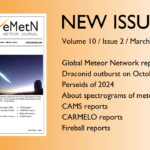Many amateurs observed the comet 21P/Giacobini-Zinner in recent weeks and with the parent comet of the Draconids at its perihelion, the question may arise if another meteor outburst may be expected and at what time this may occur?
2018 has never been on the list for another top year of the Draconids but surprises are never to be excluded. Observers should be alert during the night 8 on 9 October 2018, especially between 20h and midnight.
Roberto Gorelli points our attention at a recently published paper on this topic “The Draconid meteoroid stream 2018: prospects for satellite impact detection” by Auriane Egal, Paul Wiegert, Peter G. Brown, Danielle E. Moser, Althea V. Moorhead and William J. Cooke.
The auhors expect the maximum will occur around 22h20m the 8th of October (λʘ∼ 195.327◦ with a half an hour uncertainty) and with a ZHR not exceeding a few tens of meteors per hour. Using another approach results in an estimated maximum around 23h51m (λʘ∼ 195.390◦) on October 8th.
Read more in the original paper: https://arxiv.org/pdf/1809.07393.pdf
What will the Draconids 2018 bring? No outburst to be expected but will we have some visually observed Draconids? The answer to this question depends on your observing efforts. In this case it is important to have observational evidence that nothing at all or some low rates are seen. Be aware this kind of relative recently produced dust trails are full of surprises and very difficult to predict.
Visual observers: be alerted 8-9 October!
Older meteor library news:
2018
- Modeling the measurement accuracy of pre-atmosphere velocities of meteoroids, by Denis Vida, Peter G. Brown and Margaret Campbell-Brown (15 July 2018).
2017
- The Mayas and Eta Aquariids in AD 250-909, by J.H. Kinsman and D.J. Asher (31 July 2017).


